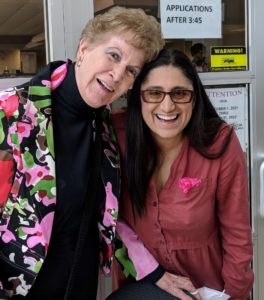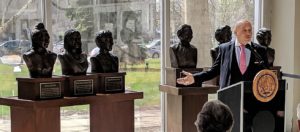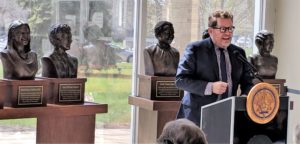By Paul Rozycki
It’s been a long and winding road, but the sculptured busts of the six women honored as “Heroines and Humanitarians” have now found their way to a permanent home in the Flint City Hall.
In a well-attended ceremony at Flint City Hall April 28, the statues of Claressa Shields, Edith Prunty Spencer, Dr. Mona Hanna-Attisha, Sybyl McPeake Atwood, Frances Willson Thompson and Olive Beasley were formally installed as a central part of the front lobby.
The project began more than three years ago, under the direction of Flint sculptor and Flint Art Institute instructor, Jane Trotter. Nearly 15 years ago, Trotter sculpted a bust of the late Flint community powerhouse Sybyl Atwood, and in the years that followed realized that Atwood was not the only woman who had contributed much to the community and deserved recognition.

Sculptor Jane Trotter (left) with Dr. Mona Hanna-Attisha. (Photo by Paul Rozycki)
Working with her sculpture students at the Flint Institute of Arts, Trotter selected six women who were the “Heroines and Humanitarians” who have made a major difference in the Flint community.
Yet, even as the clay models were made three years ago, it would take some time, energy, and money to convert those models to the final bronze sculptures and find a home for them. The COVID pandemic added more delays.
Over the last three years, before the Flint City Hall was chosen for the display of the six busts, suggestions were made that they be placed in the new Flint Public Library, or with the Chamber of Commerce, or among several potential locations in downtown Flint. In the end the goal was to keep all six together and the lobby of the Flint City Hall was chosen as their permanent home.

Mayor Sheldon Neeley speaks about the lives of the Heroines and Humanitarians. (Photo by Paul Rozycki)
Mayor Sheldon Neeley welcomed those attending by saying that the women richly deserved to be honored, and that even though April wasn’t Women’s History Month, that “every month is Women’s History Month.”
Flint City Council members Dr. Ladel Lewis (2nd Ward) and Allie Herkenroder (7th Ward) read a proclamation from the City of Flint recognizing the achievements of the six women and praising their contributions to the city.
In addition to the efforts of sculptor Jane Trotter and her students, one of the other active forces behind the “Heroines and Humanitarians” project was the Court Street Village Nonprofit, led by Doris and Norma Sain, who described the history of the project and some of the barriers and challenges it faced over the last three years.
Each of the “Heroines and Humanitarians” was introduced by a colleague or friend, and most had a chance to respond to the honor.
- Claressa Shields, was introduced by Pastor Robert McCathern, who described her as an inspiration to many. The Flint boxer is a two-time Olympic gold medal winner and holds 12 professional titles and the only boxer is history to be an undefeated two division champion. She has become a model for many young people in Flint and Genesee County. Sculptor Dee Moreno created Shields’ sculpture.
- Edith Prunty Spencer was introduced by Flint Public Library Director Kay Schwartz who spoke of Spencer’s many years of commitment to the library. Spencer has been a leader and active member of the Flint NAACP for more than 60 years. Her plaque describes her as an advocate for justice, equal opportunity and voting rights. She had served on at least 14 civil and charitable organizations that promoted education. Jane Trotter completed the bust of Edith Spencer.
- Mona Hanna-Attisha, M.D, was introduced by Ingrid Halling. Dr. Hanna-Attisha became one of the first voices for those harmed by the Flint water crisis. By challenging her critics both within and outside of the city, she became a leader in the campaign to deal with the Flint water crisis. She advanced efforts to mitigate the effects of lead on the children of Flint. Artist Jan Hanson did the statue of Dr. Hanna-Attisha.
- Dale Weighill, Associate Vice President of Institutional Advancement at Mott Community College, described his working relationship with the late Sybyl McPeake Atwood, at the Resource Center.

Dale Weighill, Associate Vice President for Institutional Advancement at Mott Community College introduces the Sybyl McPeake Atwood bust.(Photo by Paul Rozycki)
Atwood worked for more than 40 years to advocate for the poor, the sick, and the elderly. In her role with the Resource Center she motivated and organized countless volunteers for causes and projects that improved life in Genesee County. She is remembered with the SYBYL Award given to those who make a difference in their community. It was Jane Trotter’s completion of the Atwood’s bust that began the project.
- Karima Amliani was scheduled for the introduction of Frances Willson Thompson, but Sue Peters, vice president of the Community Foundation of Greater Flint, filled in. Frances Willson Thompsonn was a donor and philanthropist for many causes and projects in Flint, particularly those with the University of Michigan -Flint. She had been the major motivating factor behind the Frances Willson Thompson Library, and the Critical Issues Forum at the UM-Flint. As her bust was completed, her granddaughter Susie said of her, “She loved Flint so much and was so thankful for all that Flint had given to her family and her that she wanted to give back.” Trotter sculpted the Thompson bust.
- Olive Rankin Beasley was described by Ernelle Taylor, who described Beasley as one of the major leading in civil rights in Flint. She had been called the “matriarch of the civil rights movement in Flint,” and devoted her life to racial equality and racial harmony. She championed the efforts to make Flint the first city to pass a fair housing ordinance. Carole Goyt is the sculptor who did Beasley’s statue.
In concluding the event both Mayor Neeley, Doris Sain, and Jane Trotter thanked all those who supported the project with both their time and money over the last three years. Many of those who were involved in the project attended and shared their experiences and thanks personally after the formal presentations.
The busts will remain on permanent display in the lobby of the Flint City Hall.
EVM columnist Paul Rozycki can be reached at paul.rozycki@mcc.edu.


You must be logged in to post a comment.